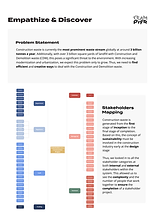
SERVICE DESIGN CHALLENGE
01
The premise of this competition was to design a solution wherein products at the end of their life cycle are repurposed in a lucrative, sustainable way. By closing the loop, it would would be possible to recapture the value of various products/parts/materials. Over the course of 6 months, my team progressed through 4 stages of the competition reaching the final round
We took a multi-framework approach -
-
Our research and design flow was guided by the 'Double Diamond' approach wherein our problem space was explored from a broad and narrow lens in a cyclic manner
-
In line with IBM's 'Enterprise Design Thinking', we engaged in a continuous cycle of observing, reflecting and creating keeping the user at the heart of our exploration and design
-
Harnessing the power of Philips Design ‘Co-creation', we collaborated with industry experts and seasoned design thinkers at every stage
CONTEXT & FRAMEWORK

IDENTIFY & EXPLORE
Role: UX Researcher & Visual Designer
The focus of this phase was to gather enough research to narrow down on a problem space. To ensure sound logic, we equipped ourselves with information on circular systems, talked to local experts, created a system map to visualize all factors and stakeholders.
Ultimately, we honed in on construction waste. We all agreed that there was a scarcity of avenues to keep materials & tools in the loop after medium to large scale construction and demolition projects. We identified major opportunities to turn construction trash to treasure.



EMPATHIZE & DISCOVER
We gained a more nuanced understanding of stakeholder complexities and extent of influence through one-on-one interviews. Journey maps helped us conceptualize the involvement of key stakeholders at various project stages.
Ethnographic probes helped us capture pain points, biases and knowledge gaps across key stakeholders. By the end, we developed a deep understanding of domain-specific challenges and emotional intricacies in construction projects.






FRAME & DEFINE
We compiled the most inspiring user stories to arrive at a meaningful synthesis of the most pressing need gaps. This was a crucial phase to re-evaluate our problem space and realize new opportunities to design solutions for.
An ELSI analysis helped us map the extensive set of relationships between construction waste and the surrounding world. Our re-focused challenge was to ideate for a financially viable way to reuse utilizable construction waste.




IDEATE & DEVELOP
In the final phase, we reached into the depths of our creative souls and pulled out the best solutions we could think of. The aim was to diverge before converging. We ran solutions by industry & business experts in multiple co-creation sessions. Our final idea resulted in a web service for reusing materials.
We improved our high fidelity prototype through iteration and compiled the best idea into an experience prototype for a minimum viable service (see pdf & video). Our service blue print outlined the different customer actions, features, front-end & back-end processes along with support processes.






REFLECTION
Highlights
Challenges
New ideas
ROSE
THORN
BUD
At no point did we shy away from the unknown - we used contemporary, unfamiliar research methodologies and ideation frameworks. Through blueprints, synthesis techniques, maps, matrices we efficiently organized our thinking
Narrowing down the ocean-wide problem space was a harrowing process. In our primary research phase, we realized that the construction industry has highly standardized modes of operation. This made the task of ideation daunting at first
While our ideation process ended up being extremely exhilarating, it could have been more focused. For example, the Six Thinking Hats brainstorming technique could have led to a higher degree of sequential creative strategizing